Emphasis on By Type (Sub-Orbital, Orbital, Others), By End User (Commercial and Government) and Regions (North America (The US, Canada), Europe (Germany, The UK, France, Rest of the Europe), Asia-pacific (China, Japan, India, Rest of the Asia-pacific), Rest of the World)
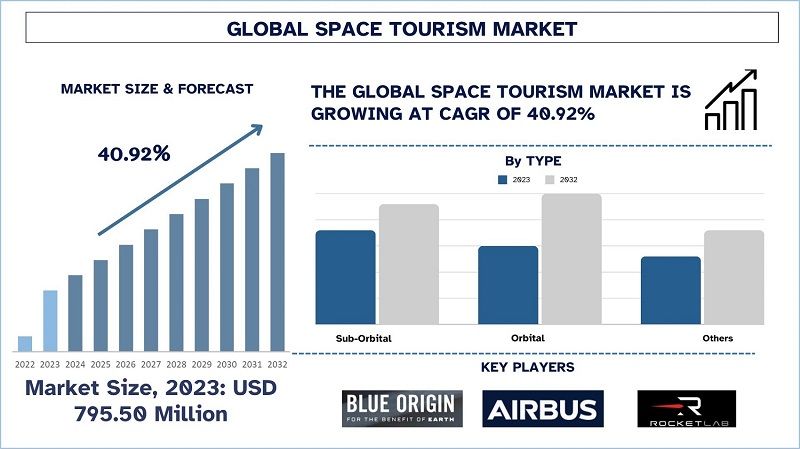
The Global Space Tourism market was valued at USD 795.50 million in 2023 and is expected to grow at a strong CAGR of around 40.92% during the forecast period (2024-2032) owing to rising demand for Space Tourism in the spacecraft industry across the globe.
The Global Space Tourism market is anticipated to exhibit a remarkable growth rate during 2024-2032. With the increasing number of companies offering space travel and tourism services as well as technological and regulatory advancements in the domain, the sector has experienced a rapid boost. Space tourism has also gained sizable momentum from government space agencies opting for the commercial sector space tourism application to reduce the cost.
The Global Space Tourism market was valued at USD 795.50 million in 2023 and is expected to grow at a strong CAGR of around 40.92% during the forecast period (2024-2032). One of the key factors that have supported the market growth of space tourism is the high inclination of High-net-worth individuals striving to opt for recreational space travel. The cost of space tourism has been on the higher side due to most companies opting for new-generation space propulsion systems, including reusable space shuttles, as well as looking for different space-based propulsions such as electric or ion thrusters. With the further integration of these technologies reducing the cost of travel in space, the prices are anticipated to go down, and this would support its demand in the long run.
Additionally, in recent years, many companies have started offering space tourism services, which has fostered its growth among individuals. For instance, in 2022, Axiom Space launched its first commercial space flight to send its four astronauts to the International Space Station (ISS) with a spacecraft named SpaceX Crew Dragon spacecraft.
In another instance, in 2021, SpaceX launched its Insporation4 mission spacecraft with four crew members. The mission lasted for three days, orbiting the Earth in space.
Additionally, the rise in the number of players operating in the space tourism market would support the rise with a greater number of options to travel with as well as induce the competition to further improve the technology as well as reduce the prices of space travel in the coming years.
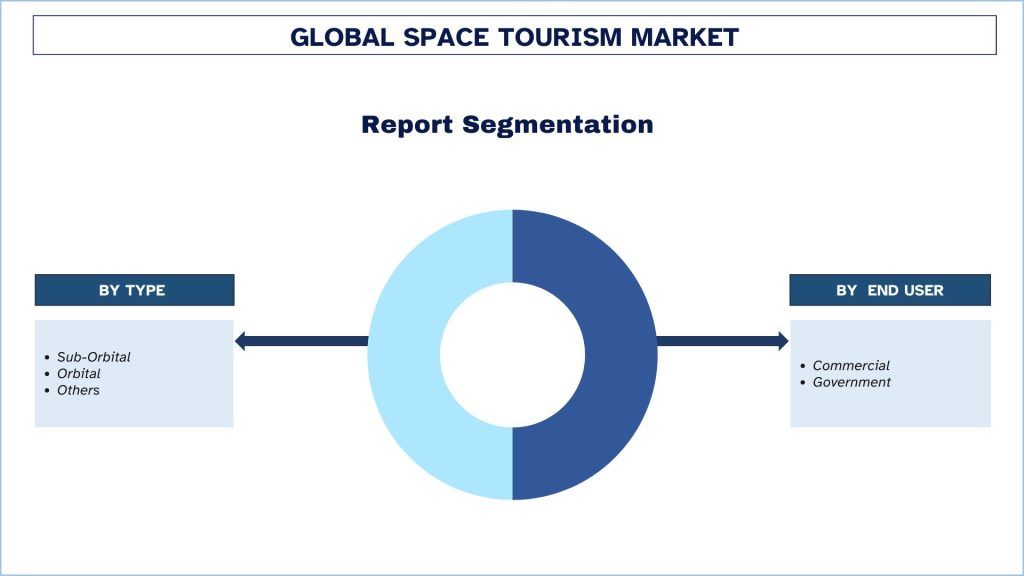
This section discusses the key market trends that are influencing the various segments of the Global Space Tourism Market as identified by our team of research experts.
Rising Demand for Sub-Orbital Flight Demand
Sub-orbital space flight has been one of the key areas of growth for global space tourism. A large number of companies are offering services under the category of sub-orbit starting after 100 km of height, after which passengers feel weightlessness or zero gravity. Additionally, this type of flight is usually less expensive than other orbital and inter-planetary travel, so space tourism providers are incessantly focusing on this. Considering the growing number of HNIs focusing on sub-orbital flights for recreational activities, the demand for the segment will further thrive in the coming years.
Considering the increasing number of space tourism providers across the globe the demand for Space Tourism activities would surge in the forthcoming years i.e., 2024-2032.
North America is Expected to Hold Major Market Share During Forecast Period
The North American space tourism market has held a major market share across the globe. One of the factors attributing to the growth is the presence of a high number of space tourism-providing companies in the region. These companies include Blue Origin, Virgin Galactic, SpaceX, etc. As many of the respective companies have already exhibited their space launch and retrieving capability, the region is leading the race to space. Additionally, the countries in the region, such as Canada and the US, have space tourism policies present for regulatory measures, due to which the industry has experienced massive support from the government’s end.
Additionally, government aerospace companies, such as NASA, have collaborated with regional commercial players to opt for astronaut-sending services. These collaborations involve providing space shuttles for sending humans on suborbital and orbital space missions.
In line with the developments, it is anticipated that the North American region will continue to dominate the Global Space tourism market in the coming years, i.e., 2024-2032.
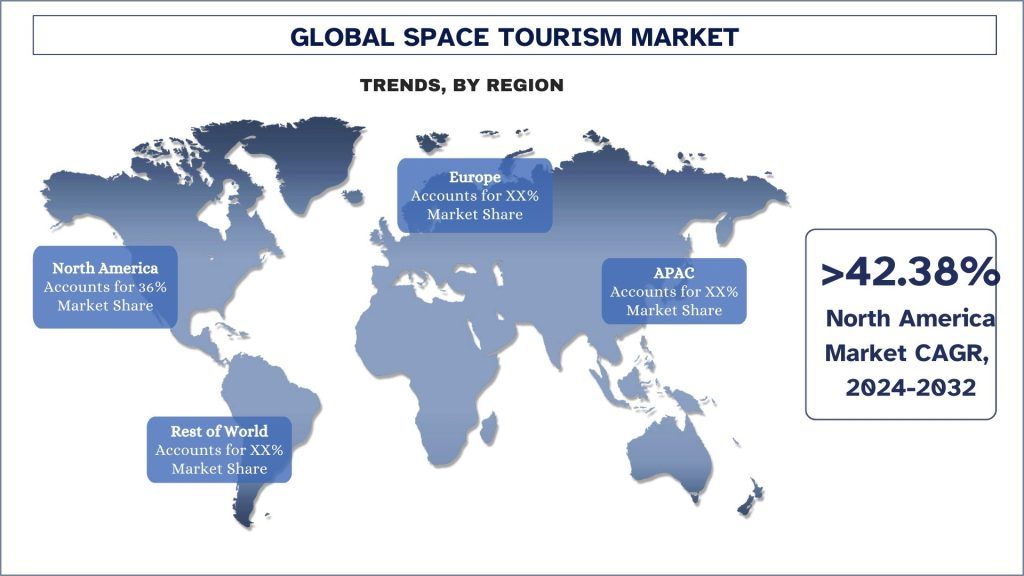
The Global Space Tourism market is competitive and fragmented, with the presence of several global and international market players. The key players are adopting different growth strategies to enhance their market presence, such as partnerships, agreements, collaborations, new product launches, geographical expansions, and mergers and acquisitions. Some of the major players operating in the market are Blue Origin, Axiom Space, Boeing, Airbus, Rocke Lab USA, Space Adventure, SpaceX, Space Perspective, Virgin Galactic, and Zero Gravity Corporation.
For instance, in 2024, Chinese state-backed company, Chinese commercial space company, CAS Space announced the launch of its first space tourism vehicle to be launched by 2027. According to the company, it will include a tourist cabin with four panoramic windows that can carry seven passengers.
In another instance, in 2024, Blue Origin resumed its space tourism after the midflight issue emerged in the year 2022. The spacecraft contains 6 passengers for sub-orbital space travel.
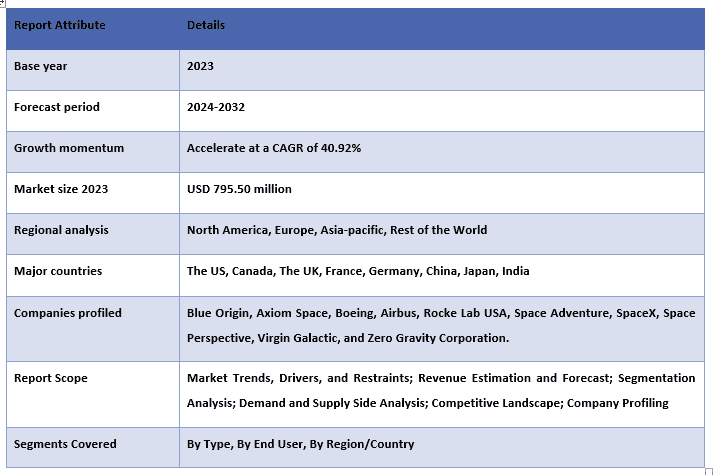
The Global Space Tourism market can further be customized as per the requirement or any other market segment. Besides this, UMI understands that you may have your own business needs; hence, feel free to connect with us to get a report that completely suits your requirements.
1. Market Introduction
2. Research Methodology Or Assumption
3. Executive Summary
4. Market Dynamics
5. Pricing Analysis
6. Global Space Tourism Market Revenue (usd Mn), 2022-2032f
7. Market Insights By Type
8. Market Insights By End User
9. Market Insights By Region
10. Value Chain Analysis
11. Competitive Landscape
12. Company Profiled
13. Acronyms & Assumption
14. Annexure
Analyzing the historical market, estimating the current market, and forecasting the future market of the Global Space Tourism market were the three major steps undertaken to create and analyze the adoption of Global Space Tourism in major regions globally. Exhaustive secondary research was conducted to collect the historical market numbers and estimate the current market size. Secondly, to validate these insights, numerous findings and assumptions were taken into consideration. Moreover, exhaustive primary interviews were also conducted with industry experts across the value chain of the Global Space Tourism market. Post assumption and validation of market numbers through primary interviews, we employed a top-down/bottom-up approach to forecasting the complete market size. Thereafter, market breakdown and data triangulation methods were adopted to estimate and analyze the market size of segments and sub-segments of the industry. Detailed methodology is explained below:
Step 1: In-Depth Study of Secondary Sources:
Detail secondary study was conducted to obtain the historical market size of the Global Space Tourism market through company internal sources such as annual reports & financial statements, performance presentations, press releases, etc., and external sources including journals, news & articles, government publications, competitor publications, sector reports, third-party database, and other credible publications.
Step 2: Market Segmentation:
After obtaining the historical market size of the Global Space Tourism market, we conducted a detailed secondary analysis to gather historical market insights and share for different segments & sub-segments for major regions. Major segments are included in the report as by type and by end user. Further regional/country-level analyses were conducted to evaluate the overall adoption of testing models in that region.
Step 3: Factor Analysis:
After acquiring the historical market size of different segments and sub-segments, we conducted a detailed factor analysis to estimate the current market size of the Global Space Tourism market. Further, we conducted factor analysis using dependent and independent variables such as by type and by end user in the Global Space Tourism market. A thorough analysis was conducted for demand and supply-side scenarios considering top partnerships, mergers and acquisitions, business expansion, and product launches in the Global Space Tourism market sector across the globe.
Current Market Sizing: Based on actionable insights from the above 3 steps, we arrived at the current market size, key players in the Global Space Tourism market, and market shares of the segments. All the required percentage shares split, and market breakdowns were determined using the above-mentioned secondary approach and verified through primary interviews.
Estimation & Forecasting: For market estimation and forecast, weights were assigned to different factors, including drivers & trends, restraints, and opportunities available for the stakeholders. After analyzing these factors, relevant forecasting techniques, i.e., the top-down/bottom-up approach, were applied to arrive at the market forecast for 2032 for different segments and sub-segments across the major markets globally. The research methodology adopted to estimate the market size encompasses:
Primary Research: In-depth interviews were conducted with the Key Opinion Leaders (KOLs), including Top Level Executives (CXO/VPs, Sales Head, Marketing Head, Operational Head, Regional Head, Country Head, etc.) across major regions. Primary findings were then summarized, and statistical analysis was performed to prove the stated hypothesis. Inputs from primary research were consolidated with secondary findings, hence turning information into actionable insights.
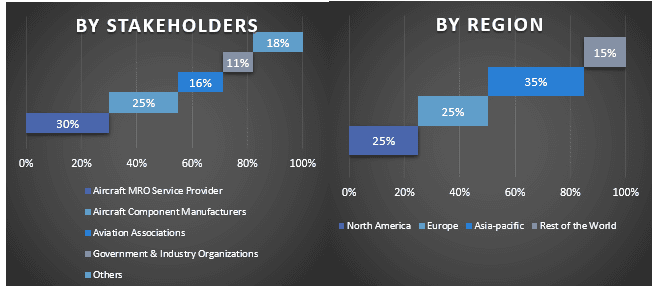
The data triangulation technique was employed to complete the overall market estimation and to arrive at precise statistical numbers for each segment and sub-segment of the Global Space Tourism market. Data was split into several segments and sub-segments after studying various parameters and trends in the by type and by end user in the Global Space Tourism market.
The current & future market trends of the Global Space Tourism market were pinpointed in the study. Investors can gain strategic insights to base their discretion for investments on the qualitative and quantitative analysis performed in the study. Current and future market trends determined the overall attractiveness of the market at a regional level, providing a platform for the industrial participant to exploit the untapped market to benefit from a first-mover advantage. Other quantitative goals of the studies include:
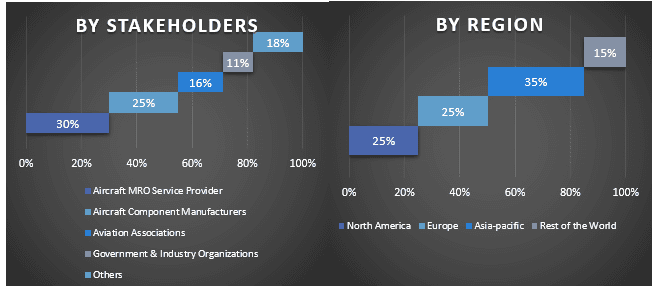
Q1: What is the current market size and growth potential of the Global Space Tourism market?
Q2: What is the driving factor for the growth of the Global Space Tourism market?
Q3: Which segment has the largest share of the Global Space Tourism market by type?
Q4: Which region will dominate the Global Space Tourism market?
Customers who bought this item also bought